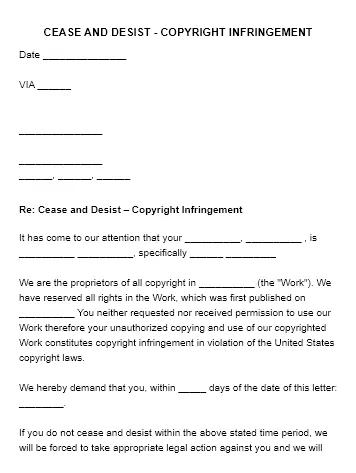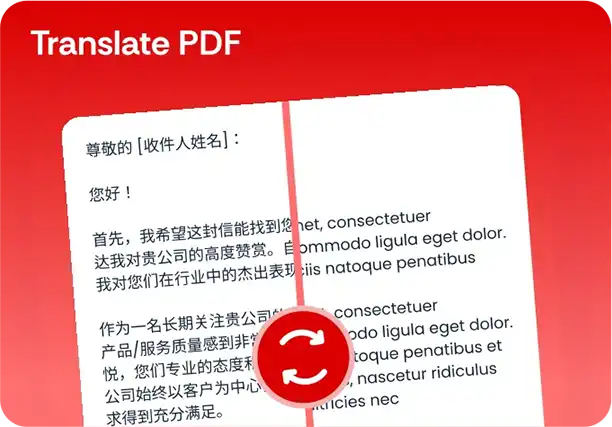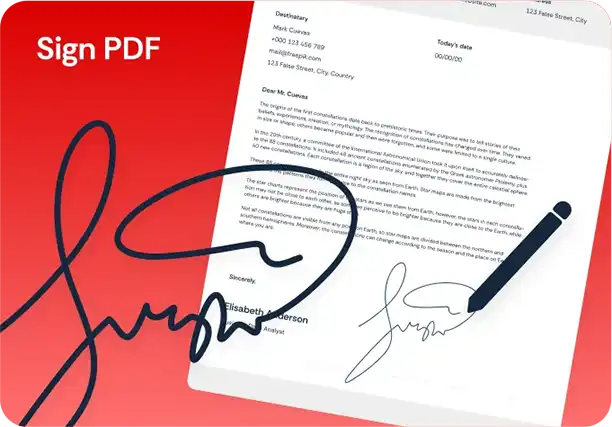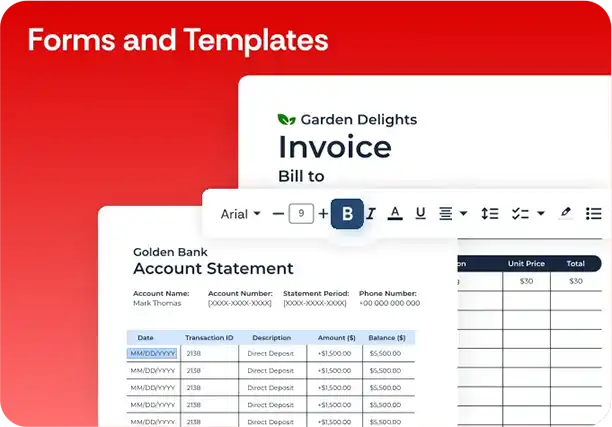Copyright Infringement Cease and Desist Letter Template
Stop searching and find out why people love the ease of creating beautiful and legally compliant Copyright Infringement Cease and Desist Letter with PDFSimpli.

Stop searching and find out why people love the ease of creating beautiful and legally compliant Copyright Infringement Cease and Desist Letter with PDFSimpli.


Pick from the colors and templates below
To Whom it May Concern:
I, ____________________, is the legal guardians of ____________,
born ________.
To Whom it May Concern:
I, ____________________, is the legal guardians of ____________.
To Whom it May Concern:
Guardian Information. We, _____ and _____, are legal guardians of _____.
Travel Consent. Child has permission to travel with _____.
Medical Authorization. We authorize necessary medical treatment.



A copyright infringement cease and desist letter demands that a person or business stop using your copyrighted content immediately. This type of cease and desist letter is also called a copyright infringement notice or copyright infringement C&D. Whether you write an article, publish a book, compose music or paint a picture, all of these creations belong to you. They’re called intellectual property, or IP. If people or businesses use any of these things without express permission, you have the right to demand they stop.
As the original author, you can use your content however you want, including licensing it, selling it or profiting from it. The Digital Millennium Copyright Act covers online creations such as digital images, blog articles, website pages, social media posts, music files, and many more items. Sending a copyright infringement cease and desist letter is one of the most important steps for protecting your rights.
This document lets people know they’re breaking the law and infringing on your copyrighted content. Sometimes, a friendly warning is all someone needs to stop using your intellectual property. Also, a cease and desist warns the offender of possible legal action. This tells the infringing party that you’re serious about protecting your intellectual property.
The purpose of a copyright infringement letter is to protect your IP and keep others from using it without permission. This situation usually happens online, where people may try to copy something you created and pass it off as theirs. They may use your music, artwork, or digital photos on a website or in videos. Use a copyright infringement cease and desist letter to defend your copyrighted work.
You have a right to benefit from your creations. If you create content, you should be the one making money from it. Allowing someone else to copy or use images or music without authorization steals your profits. Sometimes, copyright infringement can end up associating your name with companies or causes that you don’t want anything to do with.
If you’re aware that people are using your copyrighted content but you don’t take legal action to stop them, proving a violation in the future can be difficult. You need to assert your rights using a copyright infringement cease and desist letter.
When writing a copyright infringement cease and desist letter, be detailed but keep things short. It’s easier to resolve the problem when the other party understands exactly what you’re requesting. Also, this is a serious matter, so use a serious tone. Here’s what you need to include:
Take a moment to decide what kind of tone you want to use in the letter. Gather any evidence you need to prove ownership of the copyrighted material. Don’t forget to get screenshots or video proof of the other person’s infringement.
With the right software, you can fill out a copyright infringement cease and desist letter in a few minutes. PDFSimpli is one of the most popular choices because it’s available online (and for free during your trial period). You don’t have to install an app or download a program to your computer. PDFSimpli has all the tools you need for editing PDF templates, creating PDF documents, printing and saving them for later.
The fastest way to create your copyright infringement cease and desist letter is to start with a template. This saves time because you only need to fill in a few blank areas. In PDFSimpli, use the Add Text Tool to write in these spaces. You can also change the template itself by using the Edit Text Tool. Do this if you need to change the wording of paragraphs to make them sound stronger.
Go over your document one more time to make sure everything sounds the way you want. Check the details of the offending person or business, especially the mailing address.
When you’re happy with the finished cease and desist letter, click “Save.” You can save this document in your PDFSimpli account for as long as you want. That way it’s easy to use it again if this problem occurs in the future. Click “Print” if you’re planning on mailing the form personally. Another option is to use PDFSimpli’s Send for Signature Tool to request an e-signature immediately.
The most important thing is being able to prove that you are the creator of the content, along with the date you created it. You also need evidence that the offender used the copyrighted content, such as screenshots or videos. Save all correspondence regarding copyright infringement, including emails, cease and desist letters, and notes from phone calls. If possible, send the cease and desist letter by certified mail so you have a receipt of delivery.
The right actions depend on how severe the alleged infringement is. Many people start with a phone call or text message asking the offender to remove copyrighted content. You can also contact service providers online (i.e. YouTube, GoDaddy, Facebook, and Google) with a DMCA takedown request. The next step is to send a copyright infringement cease and desist letter. If this doesn’t work, you may have to contact a copyright attorney to start formal legal proceedings or sue for damages.
If you would rather avoid taking the offender to court, you may get good results by sending multiple copyright infringement notices. Your first cease and desist letter may sound like a firm-but-polite request. If the offending party doesn’t take action in the required time frame, send another C&D, this time warning of serious consequences. If this doesn’t work, you may have to threaten imminent legal action.